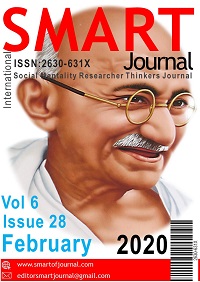Ülkemizdeki İlk Kayıtlardan Günümüze Geleneksel Türk Müziği Topluluklarında Kullanılan Kayıt Yöntemleri
Author :
Abstract
Araştırmanın amacı, ülkemizde alınan ilk ses kayıtlarından günümüze, geleneksel Türk müziği topluluklarında tercih edilen/kullanılan ses kayıt zinciri ve kayıt yöntemleri hakkında bilgiler verip sınıflandırmaktır. Bu amaç doğrultusunda bulguları elde etme için, doküman/belgesel tarama ve görüşme tekniklerinden yararlanılmıştır. Elde edilen bulgular doğrultusunda, ses kayıt zinciri ve yöntemlerini sınıflandıran literatür hakkında bilgiler verilip çalışmamıza en uygun araştırma çerçevesinde sınıflandırma yapılmıştır. Araştırmada elde edilen sonuçlar üç kategoride ele alınmıştır. İlk kayıtlar döneminde, “sil baştan” veya “tek seferde”; geçiş döneminde, “real time stereo” (gerçek zamanlı stereo), “real time mixing” (gerçek zamanlı miks) ve “overdubbing” (üst üste); bilgisayar döneminde ise, “real time mixing” (gerçek zamanlı miks) ve “overdubbing” (üst üste) kayıt yöntemlerinin tercih edildiği görülmektedir. Günümüzde sahne ses kayıt zincirinde ise “real time mixing” (gerçek zamanlı miks) kayıt yönteminin kullanıldığı sonuçlarına varılmıştır. Bu sonuçlar çerçevesinde, araştırmada ayrıca anlam karmaşasına yol açan “multitrack” (çok kanallı) kayıtlar irdelenmiştir. Böylelikle bu araştırma literatüre katkı sağlaması açısından önem arz ettiği düşünülmektedir.
Keywords
Abstract
The aim of the research is to provide information about and classify the sound recording chain and recording methods preferred/used in traditional Turkish music communities since the first sound recordings taken in our country. For this purpose, document/documentary scanning and interview techniques were used to obtain the findings. In line with the findings obtained, information about the literature that classifies the sound recording chain and recording methods have been given and the classification has been made within the framework of the most appropriate research for our study. The results obtained in the research are discussed in three categories. In the first registration period, "delete all over" or "one time"; in the transition period, "real time stereo", "real time mixing" and "overdubbing"; In computer period, it is seen that “real time mixing” and “overdubbing” recording methods are preferred. Today, it is concluded that the real time mixing method is used in the stage sound recording chain .In line with these results, "multitrack" recordings that cause confusion are also examined in the research. Thus, this research is considered to be important in terms of contributing to the literature.
Keywords
- Aktütün, B. (2007). Stüdyo Ortamında Türk Müziği Çalgılarının Kayıt Özelliklerinin Belirlenmesi.
- Aktütün, B. (2007). Stüdyo Ortamında Türk Müziği Çalgılarının Kayıt Özelliklerinin Belirlenmesi. Yüksek Lisans Tezi, Haliç Üniversitesi Sosyal Bilimler Enstitüsü, İstanbul.
- Bartlett B. & Bartlett J. (2009). Practical Recording Techniques: The Step-By-Step Approach To Professional Audio Recording (5th Edition), NewYork: Focal Press.
- Bartlett B. & Bartlett J. (2014). Recording Music on Location: Capturing the Live Performance (2th Edition), Oxford: Focal Press.
- Best, J., W. & Kahn, J., V. (2017). Eğitimde Araştırma Yöntemleri, Nitel Araştırma Bölümü (Çeviren: Mustafa Durmuşçelebi), (Editör: Onur Köksal). Konya: Dizgi Ofset.
- Bregitzer, L. (2009). Secrets of Recording, USA: Focal Press.
- Cereci, S. (1987). Radyoda Canlı Yayından Bant Yayınına Geçiş. İstanbul Üniversitesi Sosyal Bilimler Enstitüsü, İstanbul.
- Crich, T. (2005). Recording tips for engineers (2th Edition), USA: Focal Press.
- Durmaz, S. (2001). Spektral Audio Bilinci ve Kaset Kültürü, Popüler Müzik Araştırmaları Derneği Dergisi. 1 (1) 140–157.
- Eargle, J. (2006). The Microphone Book (4th Edition). Oxford: Focal Press.
- Gibson, B. (2002). Sound Advice on Microphone Techniques. London: Artistpro Publishing.
- Gottlieb G. & Hennerich P. (2009), Recording on the Go: The Definitive Guide to Live Recording, Boston: USA
- Huber, D., M. & Runstein E., R. (2010). Modern Recording Techniques, (7th Edition), Burlington: Focal Press.
- Işıkhan, C. (2011). Profesyonel Müzik Kayıtlarında Kayıt Yöntemlerini Sınıflandırmak. Uluslararası Sosyal Araştırmalar Dergisi, 4 (19), 429-444.
- Işıkhan, C. (2013). Müzikte Teknolojik Süreç ve Süreçteki Değişimiyle Türkiye’de Müzik Teknolojisi Eğitimi. Akademik Sosyal Araştırmalar Dergisi, 1 (1). 102-111.
- Karasar, N. (2016). Bilimsel Araştırma Yöntemi (31. Baskı), Ankara: Nobel Yayınları.
- Oflaz, D. (2008). Günümüzde Ses Kayıt Teknikleri ve Türk Müziği Kayıtlarında KullanılanYöntemler. Yüksek Lisans Tezi, İstanbul Teknik Üniversitesi Sosyal Bilimler Enstitüsü, İstanbul. Owsinski, B. (2005). The Recording Engineer’s Handbook, USA: Focal Press.
- Önen, U. (2007). Ses Kayıt ve Müzik Teknolojileri, İstanbul: Çitlembik Yayınları.
- Ramsey, F. & McCormick, T., (2009). Sound and Recording (6th Edition), USA: Focal Press.
- Shea M. (2005), Studio Recording Procedures: Tools, Tracks and Tips for Recording Any Instrument, USA: McGraw-Hill Companies.
- Tanyeri, B. (2014). Bağlamanın Elektronik Ortama Aktarım Sürecinin İncelenmesi. Yüksek Lisans Tezi, İnönü Üniversitesi Sosyal Bilimler Enstitüsü, Malatya.
- Tarikçi, A. (2012). Microphone Techniques For Bağlama Recording. Atmm 2012 Proceedings. 1-2 November. Ankara: Bilkent Üniversitesi Yayınları, 121-132.
- Tarikçi, A. (2017). “Ses Kayıt Stüdyosunda Yapılan Gerçek Zamanlı Çok Kanallı KayıtlardaYaşanabilecek Sorunlar ve Çözüm Önerileri: 5 Quartet Projesi Kayıt, Miks ve MasteringSüreçlerinin İncelenmesi”, VIII. Uluslararası Hisarlı Ahmet Sempozyumu, 12-14 Mayıs, Kütahya.Taydaş, K. (2015). Ses Kayıt Stüdyosu Ortamında Bağlama Kaydı İçin Yaklaşımlar. II. UluslararasıGüzel Sanatlar Bilimsel Araştırma Günleri Bildiriler Kitabı. 8-10 Nisan. Sivas: Cumhuriyet Üniversitesi Yayınları, 55-69.
- Ünlü, C. (2016). Git Zaman Gel Zaman: Fonograf-Gramofon-Taş Plak (2. Baskı), İstanbul: Pan Yayıncılık.
- Varol, A.; Vergili, S.; Işıkhan, C.; Kutluk, F. & Öziş, F. (2011). Türk Müziği Çalgılarında KayıtYöntemleri ve Mikrofonlama Teknikleri. Porte Akademik ve Dans Araştırmaları Dergisi, 1 (2). 21- 29.
- Wilson, A. (1999). Recording and Reproduction: Analogue Tape Recording, Audio Engineer’s Reference Book (2th Edition), NewYork: Focal Press.
- Yıldırım, A. & Şimşek, H. (2008). Sosyal Bilimlerde Nitel Araştırma Yöntemleri (7. Baskı), Ankara: Seçkin Yayıncılık.





